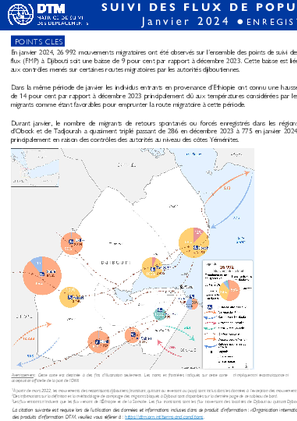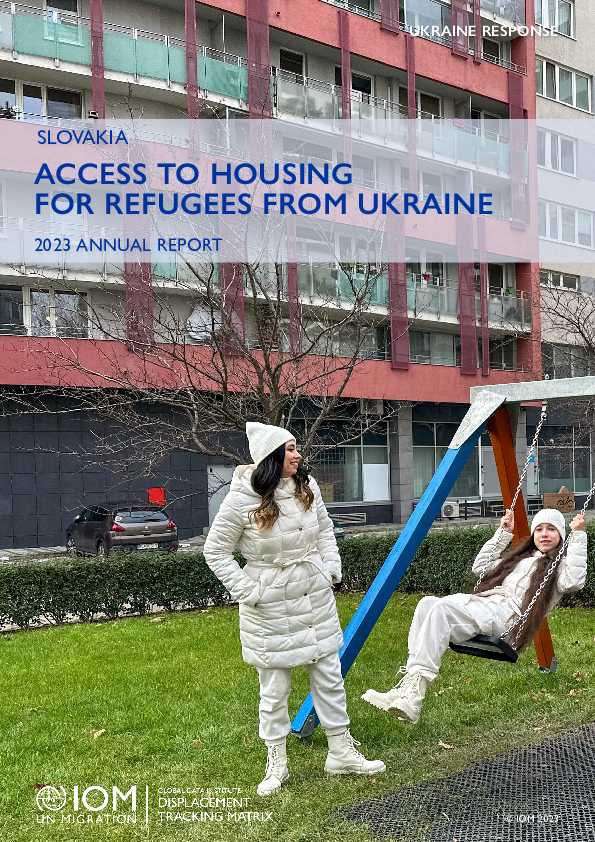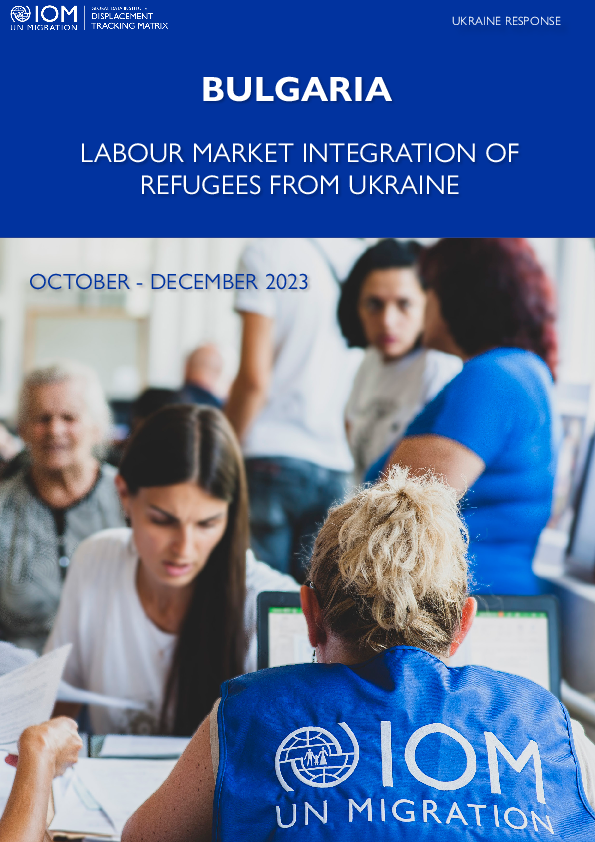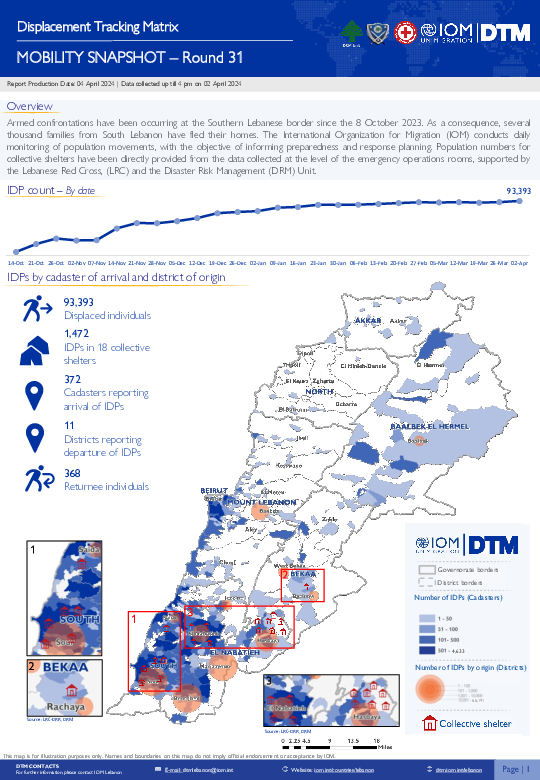-
Countries
-
Data and Analysis
-
Special Focus
-
Crisis Responses
Assessment Report

Contact
DTM Djibouti, DTMDjibouti@iom.int
Language
English
Location
Djibouti
Period Covered
Feb 01 2024
Feb 29 2024
Activity
- Flow Monitoring
In February 2024, 28,829 migratory movements were observed at Djibouti's Flow Monitoring Points (FMPs), including 14,483 incoming individuals from Ethiopia. The observed migratory movements increased by 7 per cent in February compared with January, linked to the approach of the month of Ramadan, generally considered to be an ideal time for migrants wishing to travel to the countries in the Arabian
Peninsula.
During February, the number of spontaneous or forced return migrants recorded in the Obock and Tadjourah regions rose sharply by 123 per cent, from 775 in January to 1,730 in February, mainly due to checks by the authorities on the Yemeni coast.

Contact
DTM Haiti, dtmhaiti@iom.int
Language
English
Location
Haiti
Period Covered
Apr 01 2024
Apr 04 2024
Activity
- Mobility Tracking
- Site Assessment
To continually inform humanitarian responses in the MAPAP sites, the CCCM cluster and DTM conduct regular data collections in these sites to update information on the displacement situation in the sites.
This report presents the situation as of 04 April 2024. A total of 87 sites are active in the MAPAP hosting 89,007 IDPs, this represents 0,3% more compared to 22 March

Contact
DTM Djibouti, DTMDjibouti@iom.int
Language
English
Location
Djibouti
Period Covered
Jan 01 2024
Jan 31 2024
Activity
- Flow Monitoring
En janvier 2024, 26 992 mouvements migratoires ont été observés sur l’ensemble des points de suivi des flux (FMP) à Djibouti soit une baisse de 9 pour cent par rapport à décembre 2023. Cette baisse est liée aux contrôles menés sur certaines routes migratoires par les autorités djiboutiennes. Dans la même période de janvier les individus entrants en provenance d’Ethiopie ont connu une hausse de 14 pour cent par rapport à décembre 2023 principalement dû aux températures considérées par les migrants comme étant favorables pour emprunter la route migratoire à cette période.
Durant janvier, le nombre de migrants de retours spontanés ou forcés enregistrés dans les régions d’Obock et de Tadjourah a quasiment triplé passant de 286 en décembre 2023 à 775 en janvier 2024, principalement en raison des contrôles des autorités au niveau des côtes Yéménites.

Contact
DTM Djibouti, DTMDjibouti@iom.int
Language
English
Location
Djibouti
Period Covered
Jan 01 2024
Jan 31 2024
Activity
- Flow Monitoring
In January 2024, 26,992 migratory movements were observed at all Djibouti's Flow Monitoring Points (FMPs) with a decrease of 9 per cent compared with December 2023. This drop is linked to the controls carried out on certain migration routes by the Djibouti authorities. During the same period in January, the number of people entering Djibouti from Ethiopia rose by 14 per cent compared with December 2023, mainly due to the temperatures which migrants consider to be favourable for taking the migration route at this time of year. During January, the number of spontaneous or forced returnees recorded in the Obock and Tadjourah regions almost tripled, rising from 286 in December 2023 to 775 in January 2024, mainly due to controls by the authorities on the Yemeni coast.

Contact
DTM Europe, DTMMediterranean@iom.int
Language
English
Location
Slovakia
Period Covered
Jan 01 2023
Dec 31 2023
Activity
- Survey
Key findings:
- 67% of respondents were living in individual housing and 33% in collective housing
- 16% of households had at least one infant (0-4 years old), 45% with at least one child (5-17 years old) and 31% with at least one elderly person (60+ years old).
- 14% were in need of support with accommodation
- 18% were in need of support with household goods
- 50% of respondents changed accommodation at least once while in Slovakia
- Key challenges in accessing housing include: overcrowdedness (42%), stress (15%) and lack of privacy (10%)
- 71% of respondents have received accommodation support

Contact
DTM Europe, DTMMediterranean@iom.int
Language
English
Location
Bulgaria
Period Covered
Oct 01 2023
Dec 31 2023
Activity
- Survey
Key Findings:
- Among respondents, 57 per cent are active (employed or unemployed), and 40 per cent are inactive (student status, parental leave, retirement, unemployment and not looking for a job).
- Within active population, 51 per cent are employed and 34 are unemployed, 9% were daily workers and 6% were self-employed.
- Key occupations after displacement are in professional roles (30%), services and sales (24%) and elementary occupations (13%)
- 75% of working-age stayers do not know the local language. Among working-age stayers without any knowledge of the local language (76%), 37 per cent are employed and 59 per cent are unemployed (4% unknown).
- 71% of male respondents were satisfied and 67% of female respondents were satisfied.
- Top reasons for unemployment and not looking for a job*: family duties (63%), medical conditions (11%), no need for job (10%).
DTM Europe gathers, validates and disseminates information on migrants and refugees travelling through the Mediterranean, Western African Atlantic, and Western Balkan routes to Europe. Key routes include:
- Eastern Mediterranean route (EMR): Bulgaria, Cyprus and Greece
- Central Mediterranean route (CMR): Italy and Malta
- Western Mediterranean route (WMR): Peninsular Coasts of Spain, Balearic Islands, Ceuta and Melilla
- Western African Atlantic route (WAAR): Canary Islands of Spain
DTM also monitors data on migrants in transit through the Western Balkans (WB) region (Albania, Bosnia and Herzegovina, Croatia, Montenegro, North Macedonia, Serbia, Slovenia, Romania, and Kosovo*). These are considered separately to prevent to the extent possible the double counting of the same persons that cross multiple borders to reach Europe.
This report presents the latest available data and trends, focusing on 2023:
- Mixed Migration Flows to Europe
- Migrant Flows Monitoring in the Republic of Türkiye
- First Arrival countries (Italy, Greece, Spain) and other countries of first arrival (Bulgaria, Cyprus and Malta)
- Transits through the Western Balkan region
- Migrants' presence, in Europe and the Republic of Türkiye

Contact
dtmlebanon@iom.int
Language
English
Location
Lebanon
Period Covered
Oct 10 2023
Apr 02 2024
Activity
- Mobility Tracking
- Baseline Assessment
Since October 8 there has been an increase in cross-border incidents between Israel and Lebanon, resulting in the displacement of people both within the South and elsewhere within the country. Since October 10, the Displacement Tracking Matrix (DTM) has been conducting the daily monitoring of population movements. The objective of the exercise is to inform preparedness and response planning.
The Ukrainians and Third Country Nationals Crossing Back to Ukraine report presents findings from face-to-face interviews with individuals crossing back into Ukraine from five neighboring countries (Hungary, Poland, the Republic of Moldova, Romania, and Slovakia).
The findings in this report are based off on 27,653 surveys collected by DTM in 2023 and focuses in particular on the 6,086 surveys of adult individuals going to Ukraine during the fourth quarter of 2023 (October and December, Q4). Almost all (99%) of those who surveyed were Ukrainians, and a very small proportion (1%) were Third-Country Nationals (TCNs).
In Q4 of 2023, 31 per cent of Ukrainian respondents were prospective returnees (intended to stay in Ukraine), while 49 per cent planned to go for a short visit (short-time visitors). Another 20 per cent were unsure about the length of their visit.
The report delves into the socio-demographic profiles, reasons for return, duration of displacement, oblasts of origin and destination, needs and assistance, and experiences of discrimination of the surveyed individuals. The report also provides information on individuals who have already returned to Ukraine after a period of displacement abroad as well as those in Latvia who plan to transit through the Russian Federation to reach areas of non-government-controlled areas in Ukraine.

Contact
DTM Sudan; dtmsudan@iom.int
Language
English
Location
Sudan
Period Covered
Mar 21 2024
Mar 28 2024
Activity
- Mobility Tracking
- Baseline Assessment
Overview
On 15 April 2023, armed clashes erupted between the Sudanese Armed Forces (SAF) and the Rapid Support Forces (RSF) in multiple cities across Sudan. Clashes initially took place in cities across Northern and Khartoum states, later spreading across the Darfur and Kordofan regions.
Highlights
- DTM Sudan estimates that 6,622,565 individuals (1,320,273 households) were recently internally displaced.
- The IDP caseload was observed in 7,076 locations across all of Sudan’s 18 states.
- The highest proportions of IDPs were observed across South Darfur (11%), River Nile (11%), and East Darfur (10%).
- Field teams reported that the IDPs observed were originally displaced from twelve states. The majority (3,570,032 IDPs, 54%) were reportedly displaced from Khartoum state; followed by South Darfur (15%), Aj Jazirah (9%), North Darfur (9%), Central Darfur (4%), West Darfur (4%), South Kordofan (2%), East Darfur (1%), West Kordofan (1%), North Kordofan (1%), Sennar (1%) and White Nile (<1%).
- IOM-DTM also reported that an estimated 2,031,858 mixed cross-border movements were made into neighbouring countries.
- This product provides brief insights into those displaced in Sudan post-15 April 2023. For more granular information on the IDP caseload and the displacement context, please see IOM-DTM's Monthly Displacement Overview 07.
Pagination
- Previous page
- Page 39
- Next page


